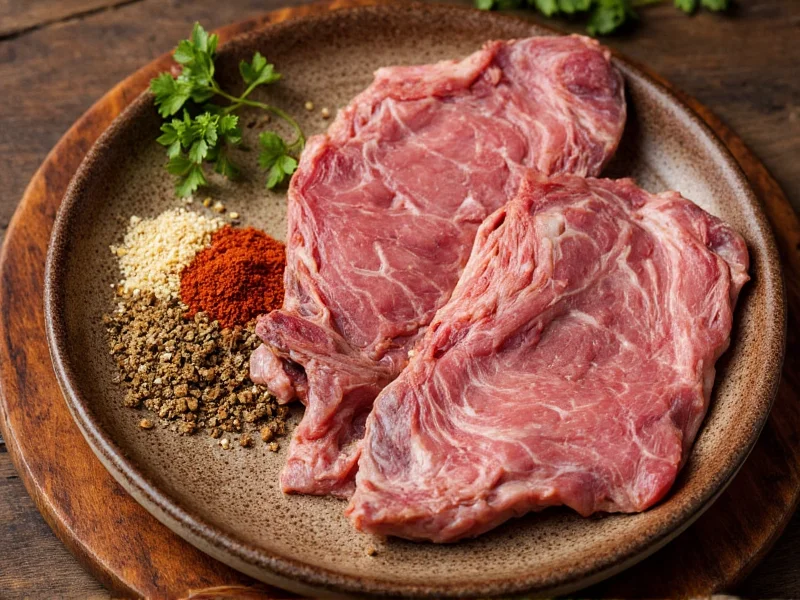Understanding which spices complement lamb begins with recognizing lamb's unique flavor profile. Lamb has a rich, slightly gamey taste with fatty marbling that responds exceptionally well to robust herbs and warm spices. The right spice combinations can enhance rather than overpower this distinctive meat, creating balanced dishes that showcase lamb's natural qualities.
Why Certain Spices Pair Perfectly with Lamb
Lamb's high fat content carries flavors effectively, making it ideal for both fresh herbs and dried spices. The meat's richness pairs particularly well with aromatic herbs that cut through the fat while complementing its earthy notes. When considering what spices go with lamb shoulder or other cuts, remember that tougher cuts benefit from longer cooking with robust spices, while tender cuts like chops work best with lighter herb applications.
Mediterranean Herb Combinations for Lamb
The classic Mediterranean approach uses fresh herbs that thrive in the same climate as sheep grazing. These combinations work exceptionally well for traditional spices used in Greek lamb recipes and other European preparations.
| Herb/Spice | Flavor Profile | Best Application |
|---|---|---|
| Rosemary | Piney, woody, slightly peppery | Roasts, leg of lamb, chops (use sparingly) |
| Mint | Cool, refreshing, slightly sweet | Mint sauce, marinades, ground lamb dishes |
| Oregano | Earthy, slightly bitter, robust | Greek souvlaki, roasted lamb, stews |
| Thyme | Floral, lemony, subtle earthiness | Braised lamb, slow-cooked dishes, stuffings |
For how to season lamb chops with herbs, create a simple rub with minced garlic, chopped rosemary, salt, and black pepper. Let the chops rest with this mixture for 30-60 minutes before cooking to allow flavors to penetrate. The garlic's pungency balances lamb's richness while rosemary's pine notes complement the meat's earthiness.
Middle Eastern Spice Blends for Lamb
Middle Eastern cuisine offers some of the most sophisticated spice combinations for roasted leg of lamb. These blends typically feature warm, earthy spices that enhance lamb without overwhelming it.
- Cumin: Earthy, warm, slightly smoky - essential for Middle Eastern and North African lamb dishes. Works particularly well with ground lamb in kofta or meatballs.
- Coriander: Citrusy, floral notes that brighten lamb's richness. Often paired with cumin in equal parts for balanced flavor.
- Sumac: Tart, lemony flavor that cuts through lamb's fat. Sprinkle on finished dishes for brightness.
- Za'atar: A blend of thyme, sumac, sesame seeds, and oregano that creates complex flavor when rubbed on lamb before roasting.
- Cardamom: Floral, citrus notes that work surprisingly well with lamb in Persian and Indian preparations.
Global Spice Traditions for Lamb Preparation
Different culinary traditions have developed distinctive approaches to what spices go with lamb based on regional preferences and available ingredients.
Indian Lamb Spicing
Indian cuisine uses complex spice blends that transform lamb into aromatic curries and roasts:
- Garam masala: The essential finishing spice blend containing cinnamon, cardamom, cloves, and black pepper
- Turmeric: Earthy, slightly bitter spice that provides color and depth
- Fenugreek: Maple-like notes that complement lamb's richness in dishes like rogan josh
- Mustard oil: Often used as a base for tempering spices in lamb curries
Moroccan Lamb Spicing
Moroccan tagines showcase lamb with sweet and savory spice combinations:
- Ras el hanout: Complex blend of up to 30 spices including rose petals, lavender, and chili
- Ginger: Fresh or dried, provides warmth without heat
- Saffron: Used in premium dishes for its floral notes and golden color
- Pomegranate molasses: Adds sweet-tart complexity to finished dishes
Practical Tips for Seasoning Lamb
When working with lamb, consider these professional techniques for optimal flavor development:
- Timing matters: Add delicate herbs like mint and parsley in the last 15 minutes of cooking, while robust spices like cumin and coriander can withstand longer cooking times.
- Balance fat content: Leaner cuts like loin benefit from oil-based marinades with spices, while fatty cuts like shoulder work well with dry rubs.
- Acidity is key: Always include an acidic element (lemon juice, vinegar, wine) in marinades to help tenderize and carry flavors.
- Layer flavors: Start with aromatics (onion, garlic), add spices early in cooking, then finish with fresh herbs.
- Don't overcomplicate: Three well-chosen spices often work better than a dozen competing flavors.
Common Spice Pairing Mistakes to Avoid
Even experienced cooks sometimes make these errors when seasoning lamb:
- Overpowering with rosemary: This potent herb can dominate if used excessively - one sprig per pound is usually sufficient.
- Mixing incompatible flavor profiles: Avoid combining strongly Mediterranean and Asian spices in the same dish.
- Adding spices too late: Many dried spices need time to bloom in oil or liquid to release their full flavor potential.
- Ignoring regional authenticity: While fusion can work, understand traditional pairings before experimenting.
- Not tasting as you go: Lamb's flavor varies by breed and diet, so adjust seasoning accordingly.
Creating Your Own Lamb Spice Blends
Developing personalized spice combinations allows you to tailor flavors to your specific preferences. Start with these foundational ratios:
- Mediterranean blend: 2 parts rosemary, 1 part thyme, 1 part oregano, 1 part garlic powder, salt and pepper to taste
- Middle Eastern blend: 2 parts cumin, 1 part coriander, 1 part paprika, ½ part cinnamon, ½ part cardamom
- Indian-inspired blend: 2 parts coriander, 1 part cumin, 1 part turmeric, ½ part ginger, ¼ part cloves
Store homemade blends in airtight containers away from light for up to three months. For the freshest flavor, toast whole spices before grinding them for your blends.











 浙公网安备
33010002000092号
浙公网安备
33010002000092号 浙B2-20120091-4
浙B2-20120091-4